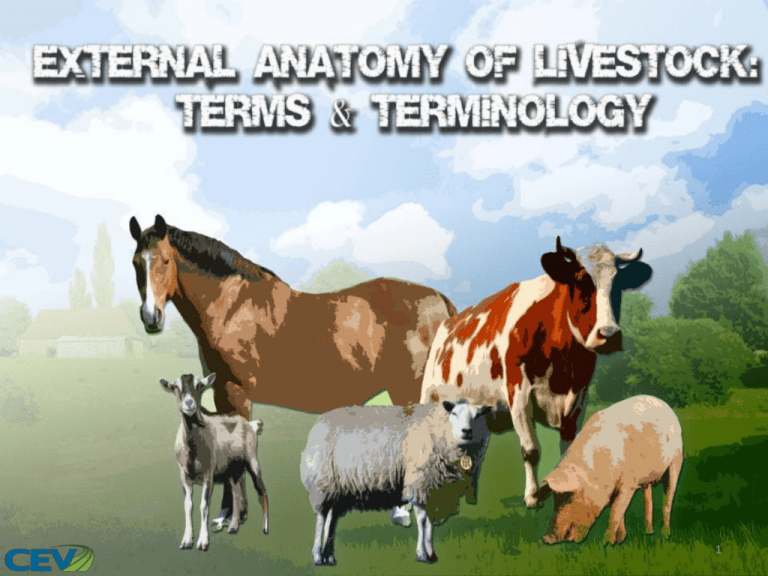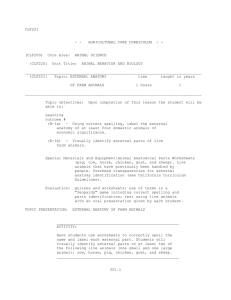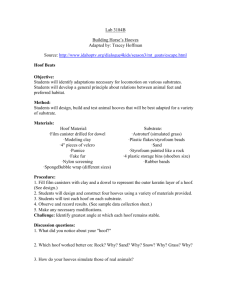Directioal and External Anatomy of Livestock
advertisement

1 Objectives 1. To identify the external anatomy of livestock species. 2. To analyze the functions of the external anatomy of livestock species. 3. To compare the external anatomy of various livestock species. 2 Table of Contents Anatomical Terms of Location External Components of Livestock Livestock External Anatomy Diagrams 3 4 Anatomical Terms of Location • Is used to avoid ambiguities • Are universal terms readily understood • Are used to eliminate confusing, descriptive words such as “top and bottom” 5 Anatomical Terms of Location • Includes: – dorsal – ventral – caudal – cranial – proximal – distal 6 Cranial • Is toward the head end of the body • Is located in or around the skull, or cranium, of the animal • Can also be known as the anterior 7 Caudal • Is directed toward or situated near the tail of the body • Can also be known as the posterior • Comes from the Latin word “Cauda” meaning tail 8 Ventral • Refers to the belly, or the underside, of the animal • Is the opposite of dorsal • Derives from the Latin word "Venter" meaning abdomen 9 Dorsal • Is referred to as the back of the body • Is the superior surface, or at the highest point, of most four legged animals • Is referred to as “Dorsum,” the Latin word meaning the back Farm Fact: Dorsal is sometimes called a trunk. 10 Proximal • Refers to a structure nearest a major point of reference • Can also be referred to as basal • Comes from the Latin word “Proximus” meaning nearest Example: The knee is proximal to the ankle. Point of reference is usually the midline of the body. 11 Distal • Is the opposite of Proximal • Refers to the end farthest from a point of reference • Derives from the Latin “Distar” meaning to stand away from Example: The ankle is distal to the knee. 12 Point of reference is usually the midline of the body. 13 Integumentary System • Is the structure which covers and protects the body • Also includes: – skin structure – hair – nails Farm Fact: The skin is one of the first systems affected for sick animals. 14 Hair • On an animal is known as fur or wool • On different mammals, can be thicker and more coarse • Threadlike pigmented structures that grow from follicles beneath the skin of mammals • Acts as an insulator and assists in regulating the temperature of the body 15 Skin • Is the soft outer covering of an animal • Is the largest organ on the body • Is made up of two layers: – epidermis – dermis Farm Fact: Pigs wallow in mud because they do not 16 have sweat glands. Epidermis • Is the outer layer of cells which forms the skin • Acts as a physical barrier to water loss • Is formed by a division of cells, push other cells to the surface, die and are shed • Contains melanin, responsible for skin, fur and wool pigmentation 17 Dermis • Is the underlying layer of the skin • Is used to regulate temperature • Supplies the epidermis with nutrient-saturated blood • Houses the hair follicles, nerve endings and pressure receptors 18 Keratin • Is a protein in the outer layer of the skin • Several types may be found in one animal • Is a chemical component of epidermal tissues, such as: – hair – hooves – horns – nails 19 Horns • Are permanent projections which grow on the head of various hoofed animals • Consist of a bone core, attached to the animals skull • Include the following uses: – fighting for dominance of territory – mating and courtship – defense 20 Auricle • Is the external part of the ear • Can also be known as the pinna • Is used to collect and focus the sound toward the ear canal • Is where an ear tag is attached Ear Tag: A plastic or metal object used to identify the animal, prevent theft and control disease outbreaks in livestock. 21 Nares • Refers to the two external openings of the nose which lead to the nasal cavity • Are the location of air entry to and exit from the animals respiratory system • Can also be referred to as: – nose – muzzle – nostril – nasal 22 Vibrissae • Are commonly known as whiskers • Are long or stiff hairs on the face or nostrils of an animal • Are possessed by many mammalian creatures including livestock • Derived from the Latin word “Vibro” meaning to vibrate • Usually employed for tactile or touch sensation 23 Mammary Papilla • Can also be referred to as the teat • Is located on both male and female mammals • Is known as an udder in cows, sheep and goats • Are the openings which lead to the mammary glands 24 Hooves • Are the tips or the toes of an ungulate • May be used for digging or in defense • On livestock, except horses, are often called a cloven hoof because of the two main hoofs on each foot • Are sometimes accompanied by a smaller structured hoof farther up the leg known as a dewclaw Ungulate: Is a mammal with hooves. Grammar Box: The plural of hoof can be written either 25 hooves or hoofs. Tail • Is a flexible appendage attached to the trunk • Can be used to brush away biting insects and flies • Can show social signaling and indicate an animal’s emotion • Contains the Coccygeal Vertebrae 26 27 Cattle Hook or Hip Tail Head Rump Pin Bone Loin Poll Ear Back or Top of Top Shoulder Neck Forehead Eye Face Muzzle Forerib Quarter Rib Shoulder Stifle Switch Hock Pasterns Throat Rear Flank Elbow Udder (cow, heifer) Cod (steer) Scrotum (bull) Dewclaw Lower Forerib/Foreflank Dewlap Point of Shoulder Brisket Forearm Knee Cannon Hoof 28 Pig Ham-Loin Junction Tail Rump Shoulder Neck Shoulder Back or Loin Blade Ear Eye Face Ham Rib Rear Flank Snout Jaw Middle Stifle Side Foreflank Hock Sheath Underline Jowl Chest Elbow Forearm Knee Cannon Dewclaw Pastern 29 Sheep Hind Saddle Dock Rump Loin Poll or Cap Top of Ear Forehead Shoulder Eye Face Back/Top Muzzle Rack Hip Ribs/Side Leg Forerib Twist Flank Shoulder Neck Point of Shoulder Breast Forearm Elbow Hock Knee Cannon Hoof Pastern/Ankle 30 Goat Tail Tail Head Rump Loin Rack Horn Withers Neck Pin Bone Rib Thigh Hock Cannon Dewclaw Muzzle Ear Beard Throat Shoulder Heart Girth Stifle Flank Barrel Scrotum Hoof Pastern Heel Poll Forehead Bridge of Nose Brisket Chest Forearm Knee Toe 31 Horse Forehead Face Poll Bridge of Nose Back Crest Point of Hip Loin Croup Withers Neck Muzzle Shoulder Throat latch Point of Shoulder Buttock Barrel Thigh Stifle Chest Forearm Knee Flank Girth Elbow Cannon Ankle Hoof Pastern Gaskin Hock Fetlock Coronet 32 Assessment Assessment 33 Assessment 1. What is the name of the highest point on most four legged animals? A. Distal B. Caudal C. Cranial D. Dorsal 2. Where is the most common place to put a tag which identifies an animal? A. Auricle B. Nares C. Skin D. Vibrissae 34 Assessment 3. Which part of the skin houses the hair follicles? A. Keratin B. Caudal C. Epidermis D. Dermis 4. Keratin is NOT found in which of the following locations? A. Hair B. Hooves C. Head D. Tail 35 Assessment 5. Which of the following is NOT an anatomical term? A. Ventral B. Caudal C. Cranial D. Vibrissae 6. Which of the following terms is also know as Vibrissae? A. Skin B. Tail C. Nails D. Whiskers 36 Assessment 7. Which of the following is called the area toward the head of the body? A. Cranial B. Proximal C. Distal D. Dorsal 8. Which of the following is NOT contained within the integumentary system? A. Skin B. Hair C. Eyes D. Nares 37 Assessment 9. Which of the following terms is the Latin word for tail? A. Distar B. Cauda C. Venter D. Proximus 10. Which external component can be used for defense? A. Bone B. Hair C. Horns D. Dewclaw 38 SOURCES • Skin Anatomy. (2000, September 1). Retrieved March 10, 2010, from Healthcommunities.com: http://www.dermatologychannel.net/skinanatomy/in dex.shtml • Stanback, D. M. (n.d.). Exercise 6: Fetal Pig Anatomy. 1-27. 39 SOURCES • Skin Anatomy. (2000, September 1). Retrieved March 10, 2010, from Healthcommunities.com: http://www.dermatologychannel.net/skinanatomy/in dex.shtml • Stanback, D. M. (n.d.). Exercise 6: Fetal Pig Anatomy. 1-27. 40 Acknowledgements Production Coordinator: Collaborator: Daniel Johnson Kevin Williams, Ed.D. Project Coordinator: Production Manager: Meghan Blanek Williams Maggie Bigham Graphic Designer: Executive Producers: Daniel Johnson Gordon Davis, Ph.D., Jeff Lansdell © MMXIV CEV Multimedia, Ltd. 41



